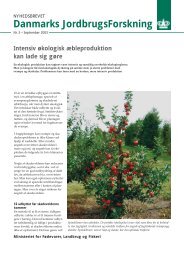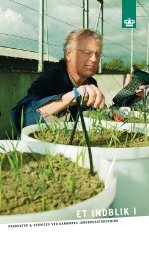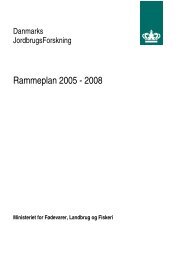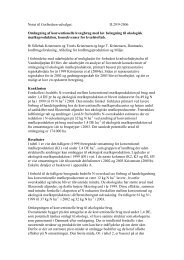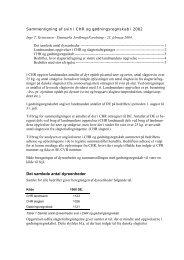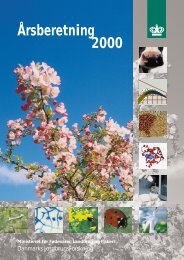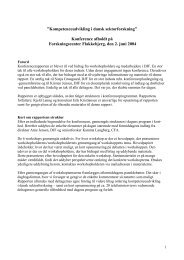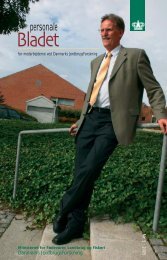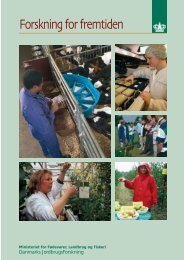Reproduction performances and conditions of group-housed non ...
Reproduction performances and conditions of group-housed non ...
Reproduction performances and conditions of group-housed non ...
Create successful ePaper yourself
Turn your PDF publications into a flip-book with our unique Google optimized e-Paper software.
- Paper IV -<br />
hour after mixing (Kongsted et al., 2004). However, sows involved in many aggressions at<br />
weaning had the fewest skin lesions three weeks after mating (Kongsted et al., 2004). As a<br />
consequence, any stress experienced by these old, <strong>and</strong> probably high ranked sows (Arey &<br />
Edwards, 1998) might have been too short lasting to influence their reproduction. The<br />
number <strong>of</strong> skin lesions has previously shown to correlate with incidences <strong>of</strong> aggressive acts<br />
(Barnett et al., 1992). However, not only physical contact but also treats <strong>and</strong> visual contact<br />
may cause stress in the submissive sows (Ruis et al., 2002). Skin lesions per se may there-<br />
fore be inadequate to determine levels <strong>of</strong> stress. Finally, the lack <strong>of</strong> relation between repro-<br />
duction <strong>and</strong> fear could partly be due to the timing <strong>of</strong> the fear tests. Fearfulness towards hu-<br />
mans around oestrus might decrease the chance <strong>of</strong> a correct timing <strong>of</strong> ovulation <strong>and</strong> in-<br />
semination (Kongsted, 2004a). However, the fear tests were not performed on the observation<br />
day around mating because the oestrus behaviour <strong>of</strong> the sows made the test results unreliable<br />
(Kongsted et al., 2004). Therefore, the fear tests were only carried out at weaning<br />
<strong>and</strong> three weeks after mating, <strong>and</strong> it cannot be excluded that the fearfulness <strong>of</strong> the sows at<br />
that time were different compared to around mating.<br />
In conclusion, with the heterogeneity <strong>of</strong> the herds involved <strong>and</strong> the <strong>non</strong>-st<strong>and</strong>ardisation <strong>of</strong><br />
possible influential factors related to layout <strong>and</strong> management in mente, the found relations<br />
are noteworthy. Taken together, the results indicate that the individual variation in feed<br />
intake in sows <strong>group</strong> <strong>housed</strong> in commercial herds may be large enough to impair pregnancy<br />
rate <strong>and</strong> perhaps also litter size. However, it cannot be excluded that the found associations<br />
between back fat <strong>and</strong> reproduction are linked to social stress. The relations between indicators<br />
<strong>of</strong> feed intake <strong>and</strong> reproduction performance may not only be a consequence <strong>of</strong> feed<br />
intake per se but a combination <strong>of</strong> low feed intake <strong>and</strong> a high level <strong>of</strong> social stress in the<br />
low ranked sows. Additional studies are needed to illuminate the role <strong>of</strong> social stress in<br />
commercial sow herds further. Special attention should be aimed at developing additional<br />
indicators <strong>of</strong> social stress suitable for use in practical pig production.<br />
Acknowledgements<br />
The author wishes to thank the participating farmers <strong>and</strong> the technicians Henrik K. Andersen,<br />
Kristine R. Hansen, Michael Hansen, Orla Nielsen, Niels H. Thomsen, <strong>and</strong> Helge Yde<br />
for their much appreciated assistance in carrying out the data collection. The author also<br />
wishes to express her gratitude to John E. Hermansen <strong>and</strong> Troels Kristensen for valuable<br />
comments on this paper <strong>and</strong> to Erik Jørgensen for valuable contributions to the statistical<br />
analyses.<br />
98




